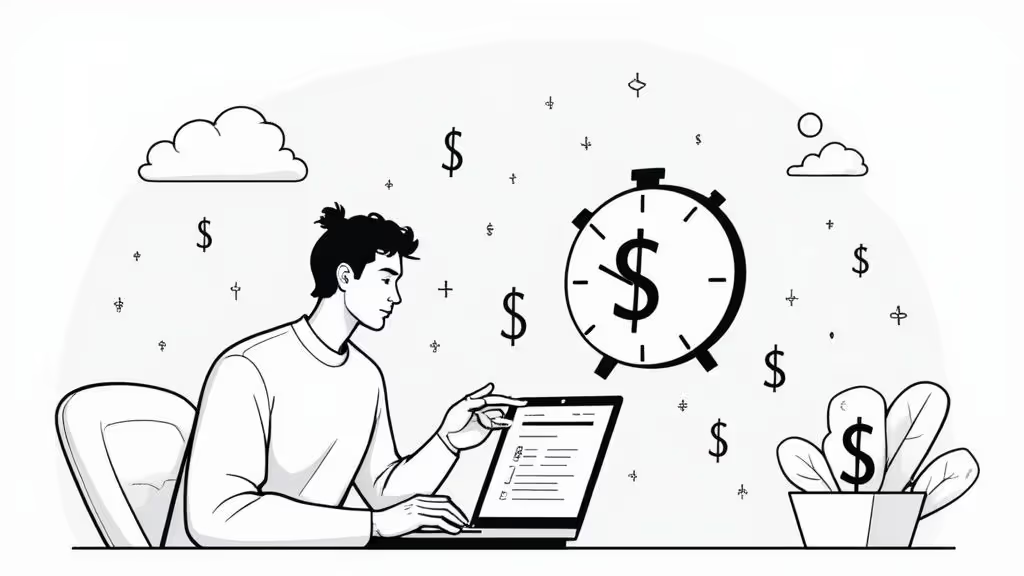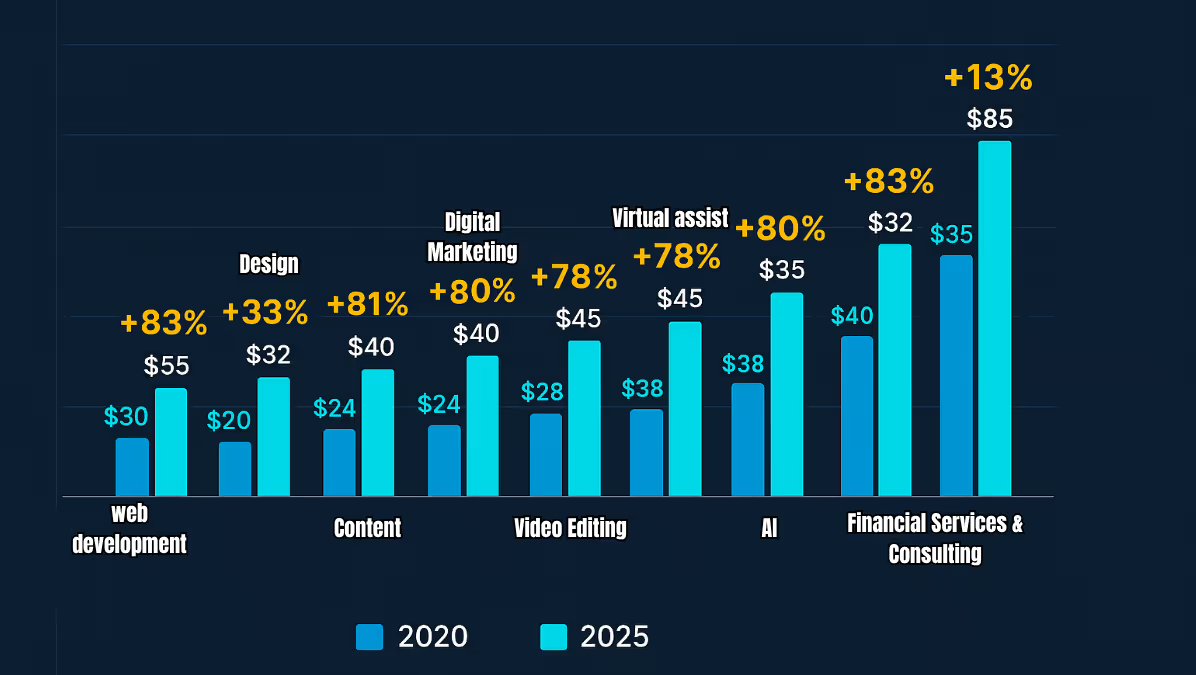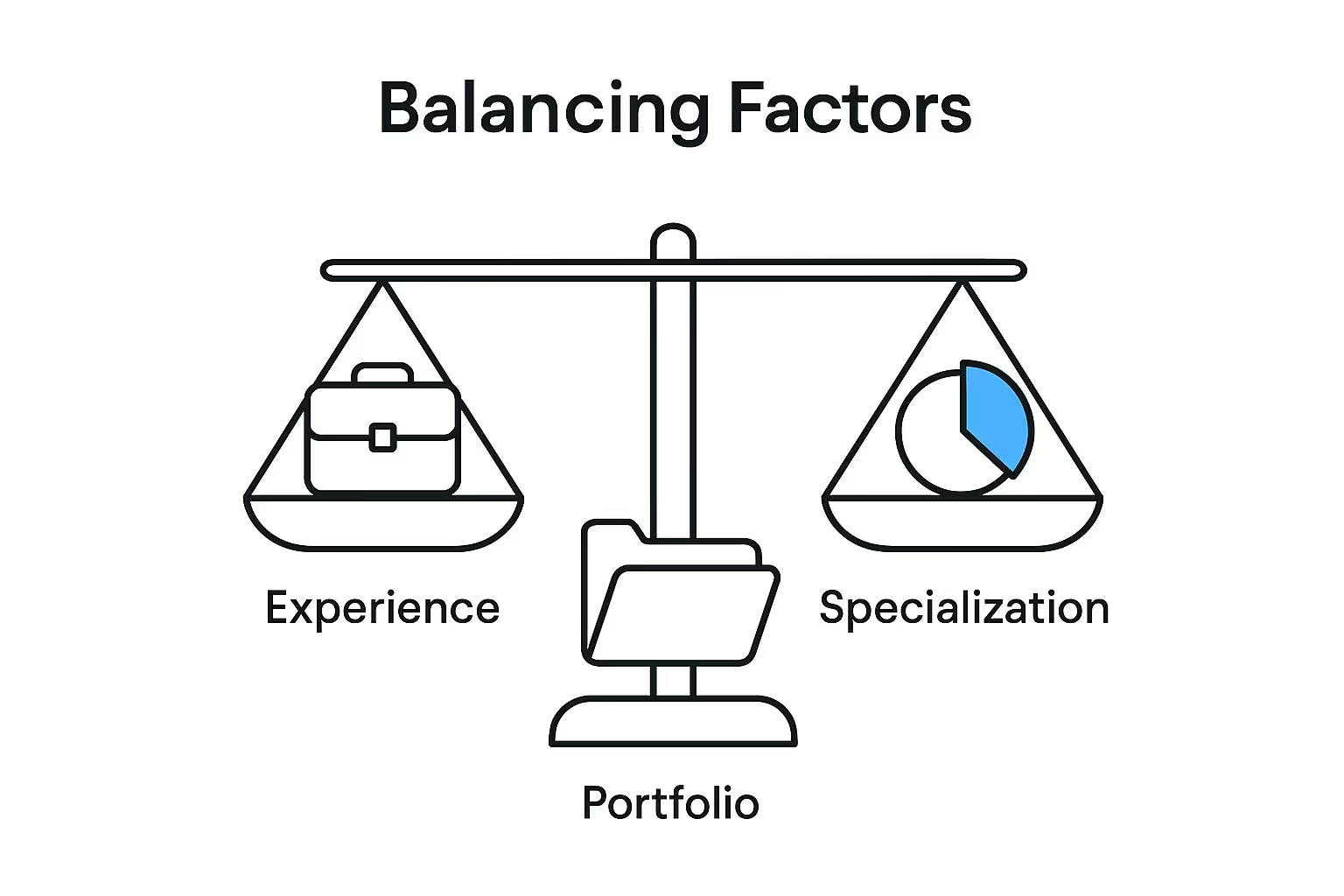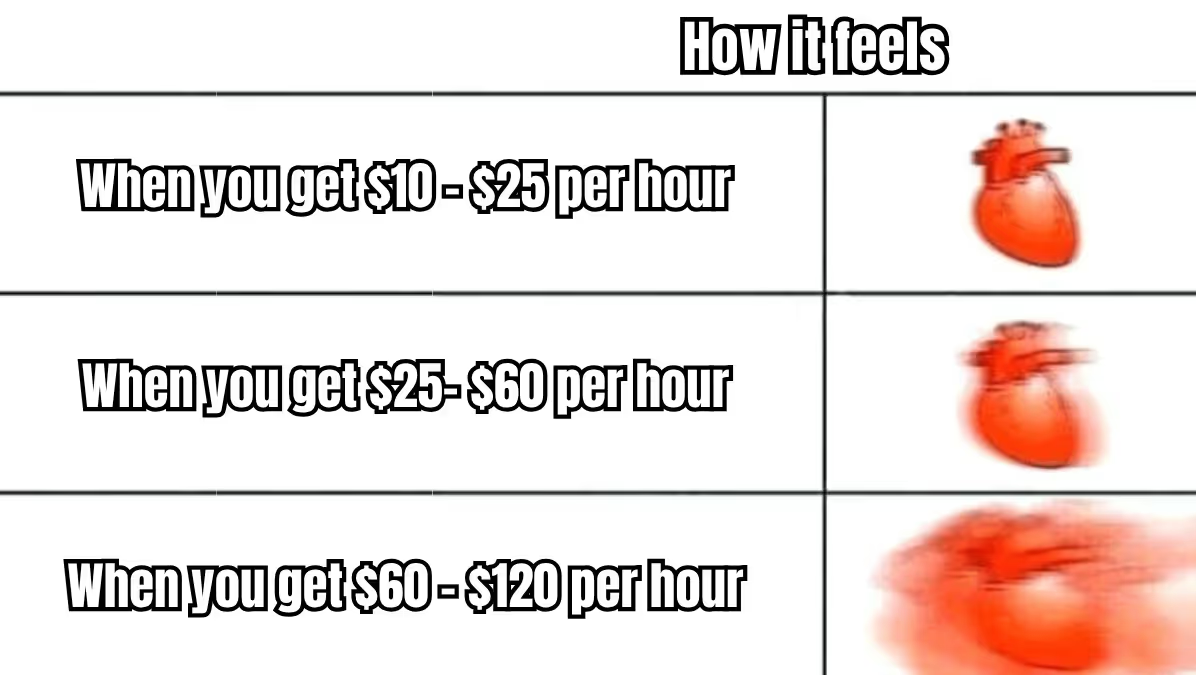Trying to figure out your Upwork hourly rate can feel like you're throwing a dart in the dark. You might see some scary-low numbers floating around - like an average of $3/hour - but let's be real. That figure includes millions of tiny, quick-hit tasks and has almost nothing to do with what skilled, professional freelancers actually make.
The truth is, a solid professional rate can easily start at $25 per hour and climb well over $100 per hour, all depending on what you do and how well you do it.
What Is a Good Upwork Hourly Rate?

So, let's clear the air. That super-low average rate you've heard about? It's incredibly misleading. It’s like averaging the price of a gumball and a gourmet steak and calling the result the average cost of food. This number lumps in simple, low-skill gigs with complex, high-value professional services, and it creates a completely skewed picture.
It’s much healthier to think of Upwork not as a bargain bin, but as a bustling global marketplace teeming with potential. For sharp freelancers, new agencies, and even established firms, it’s a direct line to high-quality clients who are actively searching for real expertise. Your Upwork hourly rate isn't just a number; it's a statement about your skills, your specialization, and the real-world results you can deliver.
Debunking the Low-Rate Myth
The myth that Upwork is a race to the bottom is one of the biggest things holding talented people back. In reality, the platform is a massive spectrum of opportunities.
Sure, Upwork reported a very low average for hourly contracts in 2023, but that’s only a tiny slice of the pie. Dig a little deeper, and you'll find that experienced pros regularly command rates from $10 to over $100 per hour. You can explore more detailed statistics on Upwork's earning potential to see just how wide that range is.
This huge variation proves a simple truth: clients on Upwork will happily pay a premium for quality, reliability, and genuine expertise. And it's not just for solo freelancers; it's a goldmine for agencies that haven't yet tapped into this client pool. By presenting a team of specialists, an agency can easily justify higher rates and attract clients looking for that exact level of service.
To give you a clearer idea, here’s a breakdown of what you can generally expect to charge based on where you are in your freelancing journey.
Upwork Hourly Rate Expectations by Experience Level
As you can see, your earning potential grows significantly as you build a track record and start positioning yourself as an expert, not just a doer.
Your Rate Is a Statement of Value
Whether you're a freelancer ready to scale or dreaming of starting your own agency, your rate is your #1 marketing tool. A low rate tends to signal low confidence, attracting clients who want cheap labor instead of a strategic partner. A higher, well-justified rate, on the other hand, communicates professionalism and value from the get-go.
Of course, the goal is to position yourself to command the rate you truly deserve. But landing those first few high-paying jobs can feel like an uphill battle. Hunting for the right projects manually is a huge time-sink, and you often end up being late to the party.
This is where automation gives you a serious edge. Tools like GigRadar find your perfect-fit jobs and ping you the second they're posted, so you can be one of the first to apply. Getting your foot in the door that quickly is what builds the momentum you need to start landing great projects in days, not weeks, and begin earning a substantial income within a month.
The Real Factors That Drive Your Rate Up
So, what separates a freelancer who confidently bills $100 per hour from someone who feels stuck at $15? It’s almost never about just logging more years in the field. The real secret behind a premium Upwork hourly rate comes down to a smart mix of specialized skill, solid proof, and top-tier professionalism.
Think about it this way: a family doctor provides incredible value, but a heart surgeon commands a much higher fee. Why? Because they have specialized, high-stakes expertise. The very same logic applies on Upwork. When you master a specific, in-demand niche, you stop being just another pair of hands and become the go-to expert.
For agencies just dipping their toes into Upwork, this is your secret weapon. You're not just a single freelancer; you're a powerhouse team of specialists. When you frame that collective expertise in your proposals, you immediately justify a higher price to clients looking for a complete, worry-free solution.
Building Your Premium-Rate Foundation
Your portfolio and profile are your most powerful sales tools for commanding top dollar. They need to tell a convincing story about why you’re worth the investment. It’s not about listing off tasks you’ve done; it’s about showcasing real, tangible results.
- Show, Don't Just Tell: Instead of saying "Wrote blog posts," frame it as "Boosted organic traffic by 40% in six months with a targeted content strategy." Numbers and concrete results do the talking for you.
- Keep Your Score Perfect: A 100% Job Success Score (JSS) isn't just for show - it's a massive trust signal. It tells potential clients you're reliable, you communicate well, and you deliver what you promise, every time.
- Communicate Like a Partner: Your soft skills are just as important as your technical abilities. Proactive updates, thoughtful questions, and a genuine partnership approach shine through in your client feedback. Clients will happily pay more for peace of mind.
Case in Point: Take Chad Gravallese, a freelance video marketer who became the #1 freelancer in his Upwork category. He didn't get there by accident. He made a conscious shift from a struggling $17/hour to a confident $65/hour by zeroing in on his niche and presenting himself as a business owner, not just a temp. This simple change attracted better clients and cemented his expert status.
From Good to Great with Smart Automation
Building this kind of reputation takes time and a whole lot of consistent effort. Manually sifting through job listings to find those high-value gems can eat up hours of your day - precious hours you could be billing. You need a system that brings the best opportunities straight to your inbox.
This is precisely where GigRadar comes in. It puts your job search on autopilot, pinging you the moment a gig matches your ideal rate and skills. This speed means you can get your proposals in front of clients first, which helps boost your profile metrics and land those critical early projects that build momentum.
For an agency or a freelancer just starting, this is the fast track to getting your first orders in a matter of days. And for seasoned pros? It means more time spent on billable work and less on the frustrating hunt. Let GigRadar’s specialists help you get set up to start winning better clients today.
How Rates Change Across Top Industries
It probably won’t shock you to hear that not all skills are valued the same. On a platform like Upwork, your Upwork hourly rate is tied directly to what the market is willing to pay for your specific expertise. It's simple supply and demand. A machine learning expert, for instance, can easily ask for three times what a general virtual assistant makes because their skills are incredibly specialized and sought-after. Figuring out where you fit in is the first step to pricing yourself with confidence.
If you run an agency that's new to the platform, this is a massive advantage. If you already specialize in hot fields like AI services or web development, you’re perfectly positioned to connect with the high-paying clients you're used to working with. For solo freelancers, understanding these industry benchmarks shows you a clear roadmap for boosting your income by leveling up your skills.

Tech and Development Take the Lead
Let's be honest, tech-focused roles consistently command the highest rates on Upwork. It makes sense. These skills are complex, they change all the time, and they have a direct, measurable impact on a company's bottom line.
- Web & Mobile Development: Developers are the builders of our digital world. A talented WordPress developer might charge around $40/hour, but it's not uncommon to see a senior full-stack or mobile app developer with a killer portfolio pulling in over $150/hour.
- AI & Machine Learning Services: This is where the real money is right now. Experts in AI, data science, and machine learning are few and far between, and demand is through the roof. Because of that, they can often set their rates anywhere from $80 to $200+ per hour.
The Value of Creative and Strategic Skills
While tech might get the biggest numbers, don't sleep on the earning potential of creative and strategic work. The key here is proving your value. When you can draw a straight line from your work to a client's business goals - like increased sales or better brand recognition - you stop being just a freelancer and become a trusted partner.
This is where your experience, portfolio, and specialized niche all come together to justify that premium rate.
Think of it like a three-legged stool. A high rate needs all three supports - proven experience, tangible results in your portfolio, and a focused specialty - to be stable.
A great real-world example is data analysts. They have this amazing ability to look at a mess of raw numbers and pull out insights that can completely change a business's direction. According to Upwork's own research, data analysts typically earn between $20 and $50 per hour, with the average landing at $30. It's a perfect illustration of how clients will happily pay more for skills that blend technical know-how with strategic thinking. You can dig into more specifics on what it costs to hire a data analyst right on Upwork’s site.
That mix of tech and strategy is what justifies a higher Upwork hourly rate. If you're a freelancer dreaming of starting your own agency one day, building a team around these kinds of high-value skills is a smart move. For a broader look at the market, the Clockify blog has a great breakdown of average hourly rates that can help you see the bigger picture.
Of course, landing clients who are willing to pay these top-tier rates means you have to be quick on the draw. Manually sifting through job postings for "expert-level" gigs is a recipe for frustration and missed opportunities. That’s where a tool like GigRadar comes in. It completely automates the search, pinging you the second a job that fits your rate and skills is posted. You get to be the first one to apply and lock down the best projects while everyone else is still scrolling.

Setting Your Rate and Planning Your Increases
Alright, let's talk about the big one: setting your rate. This can feel like a huge, intimidating step, but it doesn't have to be. Forget complicated spreadsheets or guessing games. There's a straightforward way to land on a number that actually works for you and your goals.
The trick is to work backward from what you need to earn. Think about your target annual income, toss in your business costs, and then divide that by the number of hours you can realistically expect to bill. And be honest here - you won't be billing a full 40 hours every single week. You've got to account for time spent on marketing, admin, and finding those great clients in the first place.
A Simple Formula for Your Starting Rate
Let's walk through it. This isn't just about picking a number out of thin air; it's about understanding what that number means for your business and your life.
- What's your goal? Let's say you want to bring home $60,000 a year after all is said and done.
- What are your costs? Now, add in your business expenses. Think about software subscriptions, taxes, insurance - the works. We'll estimate $12,000 for the year. That means your total revenue target is $72,000.
- How many hours can you bill? For most full-time freelancers, a realistic target is around 25 billable hours per week. That comes out to 1,200 hours a year.
- Time for the math: Divide $72,000 by 1,200 hours, and you get $60 per hour.
See? That $60/hour isn't just a random figure. It’s a strategic rate that actually supports your goals. If you're an agency just starting out on Upwork, running this calculation is absolutely crucial to make sure your pricing model is actually profitable.
How to Plan Your Rate Increases
Here's the best part: that starting rate isn't forever. It's just your starting line. As you start racking up great reviews, building out a killer portfolio, and gaining more experience, you absolutely should (and must) raise your rates. It’s a powerful signal to potential clients that your value is growing.
Case in Point: Chad Gravallese, who became the #1 freelancer in his category on Upwork, didn't get there by being the cheapest option. He made a game-changing jump from a painful $17/hour to a confident $65/hour by zeroing in on his niche and positioning himself as a business owner, not just a freelancer for hire.
This just goes to show that clients searching for true experts are more than willing to pay for that expertise. In fact, a higher rate often acts as a filter, attracting better, more serious clients who respect your skills.
Of course, getting those first few jobs to build momentum is often the hardest part. It's a classic chicken-and-egg problem, especially if you're a freelancer with dreams of starting an agency or an existing agency trying to crack the Upwork code. You need those initial projects to get the reviews that justify a higher price tag.
This is where you need to work smarter, not just harder. Instead of spending hours manually searching for jobs, a tool like GigRadar can automate the entire process for you, sending perfect-fit projects straight to your inbox the moment they're posted. This gives you a massive advantage, helping you apply first, land those initial gigs within days, and start building the reputation you need to command a top-tier Upwork hourly rate.
Ready to get moving? See how you can grow your Upwork presence with GigRadar and fast-track your journey to a fantastic income.
How to Raise Your Upwork Hourly Rate Without Losing Clients
Clients expect to pay more for value - but they won’t do it blindly. Here’s how to raise your rate strategically and keep the trust:
1. Test higher rates in new proposals first.
Don’t start by changing your public rate. Instead, test a +20–30% increase in new proposals only.
Focus on clients with:
- “Expert” level jobs
- Budgets above $1,000
- Recent spending and strong hiring history
Track the response rate. If it stays solid - you're ready to raise it platform-wide.
2. Time your increase with visible wins.
Clients rarely object to a higher rate if it comes after a strong result.
Example:
“Since we launched the redesign, conversions are up 22%. Starting next month, my rate will move from $45 to $60/hr to reflect the ongoing value.”
3. Give existing clients notice and options.
Avoid surprise hikes. Say clearly:
“Starting August 10th, my new rate will be $XX/hour. If you'd prefer to wrap up current tasks at the old rate before then, happy to do so.”
Respectful tone + clear timeline = smooth transition.
4. Position yourself as a high-leverage expert.
Clients pay more to solve painful problems. So update your:
- Profile: Focus on outcomes (“Boosted leads by 40%”), not tasks
- Portfolio: Add metrics, not just visuals
- Proposals: Lead with strategy and value, not price
5. Use rate as a filter, not a gamble.
Raising your rate helps you attract better clients, not lose current ones. Those who value results will stay. The rest? They were never your ideal audience.

Common Pricing Mistakes That Hurt Your Earnings
It's a tough pill to swallow, but countless talented freelancers and agencies leave serious money on the table. It almost always boils down to a few common, yet incredibly costly, pricing mistakes. The biggest one? Simply pricing yourself too low out of fear.
We've all been there. You worry about scaring away potential clients or being seen as "too expensive" compared to the competition. But this fear-based thinking is a trap. Setting your Upwork hourly rate too low doesn't just tank your income; it attracts the wrong kind of clients. You'll find yourself dealing with bargain hunters and micromanagers who view you as a disposable task-doer, not a long-term strategic partner.
Forgetting to Adjust Your Rate
Another classic mistake is setting your rate and then forgetting about it. Your value is not a fixed number! Every single project you complete, every 5-star review you earn, and every new skill you master makes you more valuable. Your pricing should grow right along with your expertise.
Sticking with your beginner rate after a year of solid experience is like getting a promotion without a pay raise. This is especially true for established agencies just starting out on Upwork. You already have the case studies and proven results, so don't let a new platform trick you into starting from the bottom. Your experience commands a premium rate from day one.
Case in Point: Think about the freelancer who started at a shaky $17/hour and was barely scraping by. After a mindset shift, he started focusing on the value he delivered and confidently bumped his rate to $65/hour. The result? He landed better clients, did more meaningful work, and quickly became the #1 freelancer in his niche. It’s proof that clients will pay for expertise they can see and trust.
Failing to Communicate Your Value
A high rate is just a number if you can’t explain why you're worth it. This is where so many proposals fall flat. Instead of just listing what you can do, you need to connect your skills to what the client actually wants: real, tangible business results.
Of course, you also have to be smart about the numbers behind the scenes. Your rate isn't what you take home. Remember to account for Upwork's fees, which can take a chunk out of your earnings. If you haven't already, check out our complete Upwork fee breakdown guide to see how it all works.
The Problem of Global Rate Pressure
You're not just competing with freelancers in your city; you're on a global stage. Research from Clockify shows the average freelance rate worldwide hovers around $23 per hour, but that number swings wildly depending on the industry. This global talent pool can certainly put downward pressure on rates.
But here's the flip side: it also opens up a world of opportunity to connect with clients you'd never find otherwise. You just have to position yourself correctly. Digging into these global freelance rate trends can give you a much clearer picture of where you fit in.
Navigating these pricing challenges takes more than just confidence - it takes a smart strategy. You need to be one of the first to apply to those high-quality jobs where clients aren't just looking for the lowest bidder.
Instead of spending your day manually refreshing the job feed, let GigRadar do the heavy lifting. Our specialists can help set up the tool to instantly find your ideal projects, freeing you up to focus on what really matters: writing winning proposals and getting paid what you’re truly worth.
Automate Your Job Search to Maximize Earnings
Let's be honest. A fantastic Upwork hourly rate doesn't mean much if you’re spending half your day just hunting for the next gig. Your real profitability isn't just about what you charge - it’s about how efficiently you can land work. Manually scrolling through job feeds is a huge time-drain that eats into your billable hours and frankly, leads to serious burnout.
If you're a freelancer trying to scale or an agency getting started on Upwork, this manual grind is a massive bottleneck. Every hour spent searching is an hour you can't bill a client. It's time to work smarter, not harder.
The Power of Automation
This is where automating your job search changes everything. Think about it: a system working for you around the clock, digging up jobs that are a perfect fit for your skills and target rate, and then pinging you the second they're posted. This isn't just a convenience; it's a serious competitive edge.
Getting your proposals in first matters. This speed can dramatically improve how Upwork’s algorithm sees and ranks your profile. It's not just about saving time—it's about getting in front of the best clients before your competition does. One freelancer we know directly credited his leap from $17/hour to $65/hour to this shift in mindset. He started treating his freelancing like a real business, and every good business needs an efficient way to find new leads.
Automation turns your job search from a reactive chore into a proactive strategy. It creates a steady stream of high-quality leads, freeing you up to focus on what actually makes you money: writing killer proposals and doing great work.
This is precisely why we built GigRadar. Our specialists work with you to dial in the perfect settings for your unique goals. We filter out all the noise and deliver only the relevant, high-paying jobs straight to you. The result? Less time hunting, more time earning.
To really boost your income, automating your job search is a must. You could explore tools like a powerful job board scraper to find openings faster. But for a complete, hands-off Upwork solution, GigRadar is built for the job. You can learn more in our guide on how to win clients on Upwork with automation.




.jpg)
.jpg)
.jpg)
